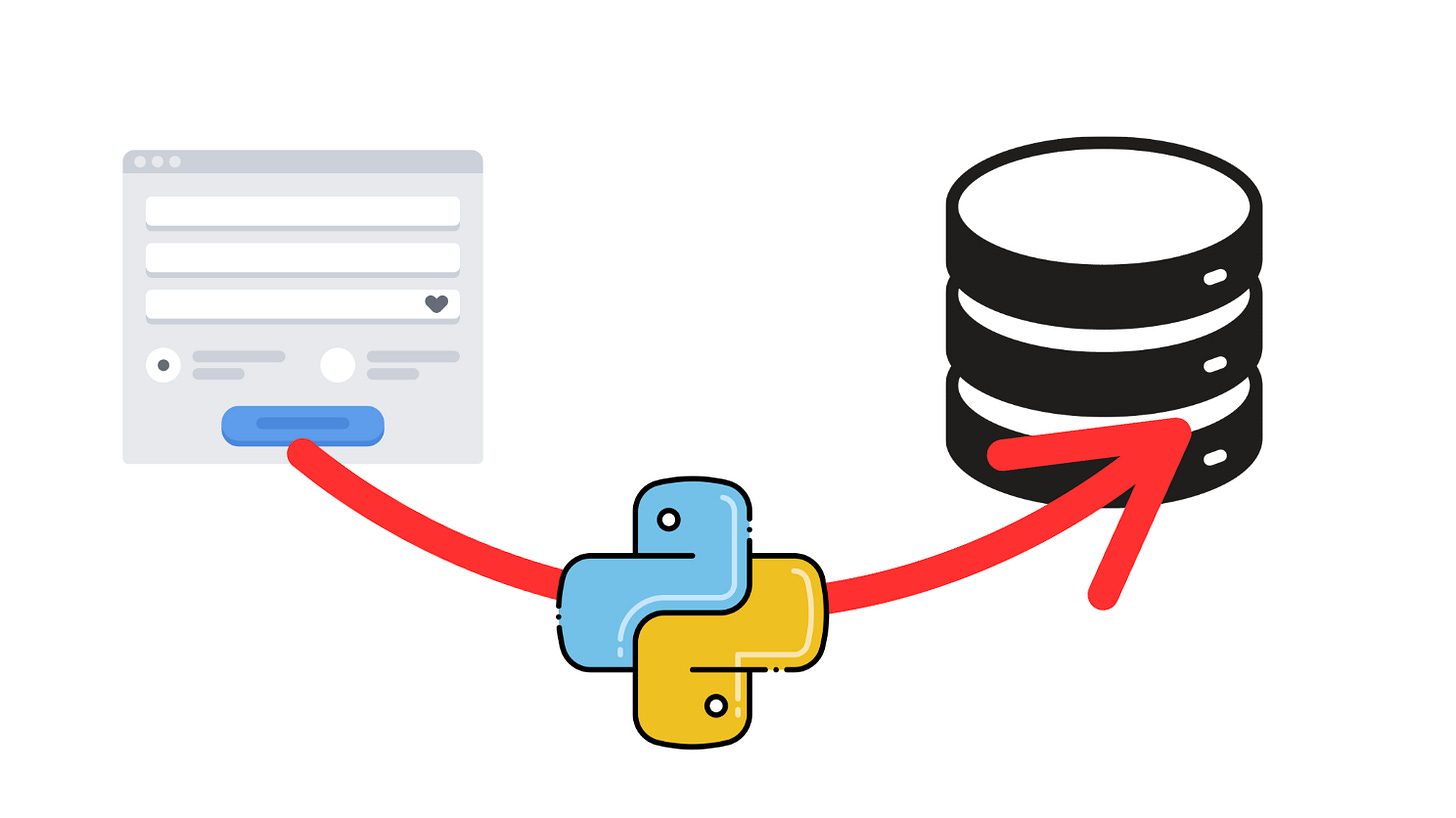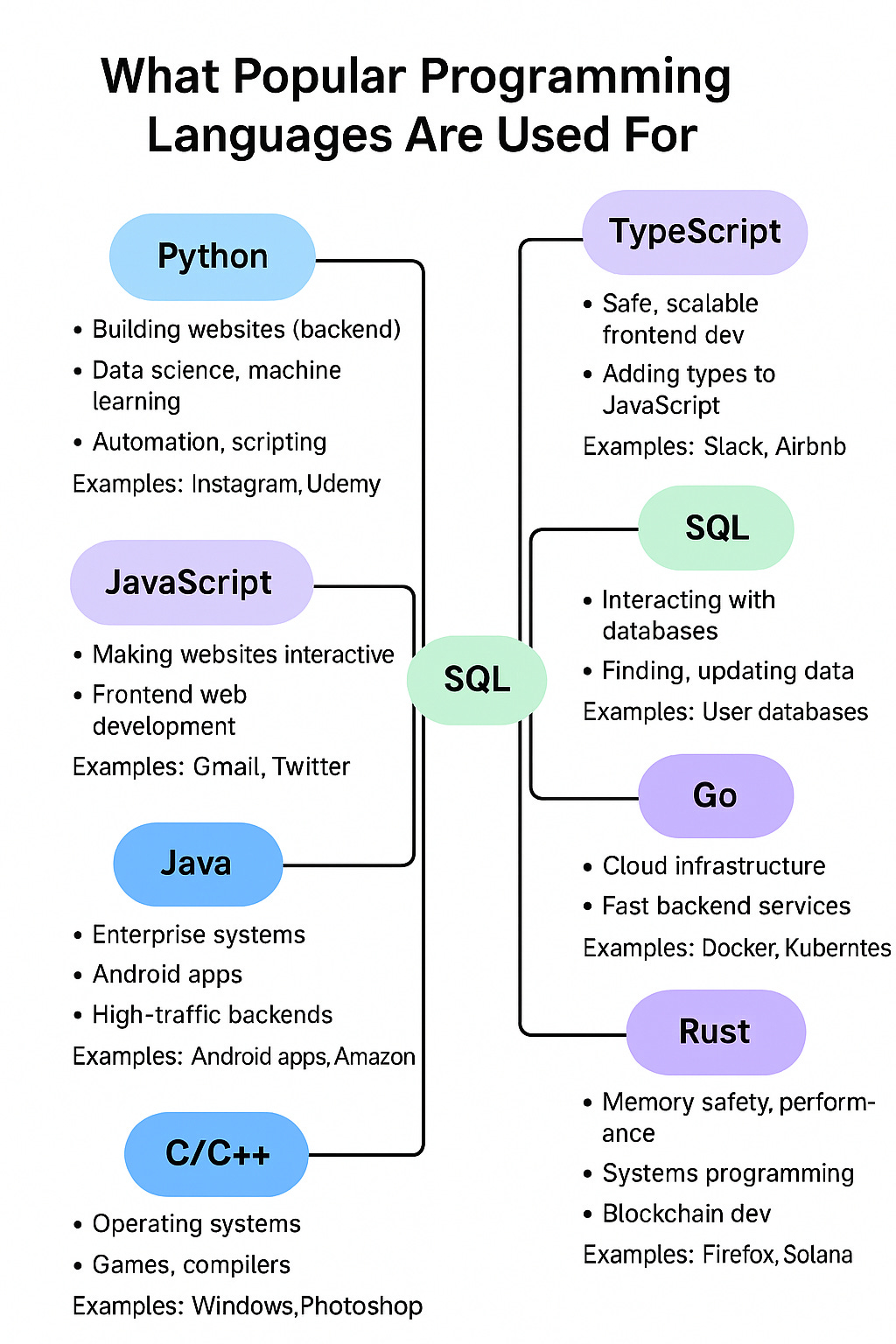What Popular Programming Languages Are Actually Used For (With Real Context)
If you’re learning to program, you’ve probably noticed: there isn’t just one language. There are dozens.
And they all seem to do different things.
This post gives you a clear, real-world overview of the most widely used programming languages today, with practical examples — not just abstract categories like “backend infrastructure.”
You’ll learn:
What each language is used for
Where it shows up in real applications
How it connects to the rest of a typical tech stack
Python
What it’s used for:
Building websites (especially the backend, where business logic and databases live)
Data science, machine learning, and data analysis
Automating repetitive tasks (renaming files, sending emails, scraping websites)
Writing scripts that “glue” systems together
Where it’s used:
Google uses Python for internal tools and AI systems
Instagram’s backend is largely Python
Udemy uses the Django web framework (written in Python) to power its entire website
What beginners should understand:
If you build a website in Python, Python handles what happens after someone submits a form or clicks a button — like storing data in a database, sending a confirmation email, or performing calculations.
Python is also widely used for data analysis. If you’ve ever seen people analyze spreadsheets or build ML models, they were likely using pandas, scikit-learn, or matplotlib — all Python libraries.
JavaScript
What it’s used for:
Making websites interactive
Building anything that runs inside the browser (drop-downs, sliders, autocomplete, etc.)
Also used on the backend via Node.js
Where it’s used:
Every modern website: Gmail, Netflix, Facebook, LinkedIn, etc.
React (a JavaScript library) powers the frontend of YouTube, Instagram, Twitter
What beginners should understand:
If you click a “submit” button and the page updates instantly without the URL reloading — that’s JavaScript. If the URL reloads, that is a backend language such as Python or PHP.
Javascript doesn’t talk directly to databases or files like Python does — it handles what the user sees and interacts with in the browser.
HTML and CSS (not programming languages, but essential)
What they’re used for:
HTML defines the structure of a webpage (headings, links, buttons)
CSS defines how it looks (fonts, colors, spacing)
Where they’re used:
Every website uses HTML and CSS
Modern websites use CSS frameworks like Bootstrap or Tailwind to save time
Here is how a webpage would look without CSS or Boostrap (left) and with CSS/Bootstrap (right).
What beginners should understand:
HTML is like the skeleton. CSS is the clothing and makeup.
Even if you use Python or JavaScript to build your app, you still need HTML/CSS to show it to users.
Java
What it’s used for:
Building complex systems for banks, insurance companies, and governments
Creating Android apps
Powering large backends that handle high traffic
Where it’s used:
Android apps are often written in Java
Netflix, Airbnb, Amazon, and many banks use Java to handle requests from millions of users
What beginners should understand:
Java is used when stability, speed, and reliability matter over time. It's popular in enterprise systems because it’s been battle-tested for decades.
Java apps often handle things like:
Payment processing
Inventory systems
Search services
Large user databases
SQL (Structured Query Language)
What it’s used for:
Interacting with databases
Finding, updating, or deleting data
Performing calculations inside the database (like counting users or summing purchases)
Where it’s used:
Everywhere data is stored in tables
Used in PostgreSQL, MySQL, SQLite, Microsoft SQL Server, and more
What beginners should understand:
Let’s say your Python app needs to find all users who signed up this week. Python sends a request to the database using SQL, and the database responds with results.
Here is a typical SQL query:
SELECT name, age
FROM students
WHERE age > 18
ORDER BY age ASC;If you were to execute that, SQL would access the “students” database table and retrieve the names and ages of students older than 18, sorted by age in ascending order.
SQL isn’t a general-purpose language — you use it to communicate with relational databases.
TypeScript
What it’s used for:
The same things as JavaScript — but with types, which help prevent bugs
Building larger, more complex frontends where reliability matters
Where it’s used:
Microsoft, Slack, Asana, Airbnb, and most large-scale web apps
Often used with React, Angular, or Vue
What beginners should understand:
TypeScript is just JavaScript with safety checks. It helps developers avoid subtle bugs in large codebases by catching errors during development.
It compiles to JavaScript — browsers don’t run TypeScript directly.
Go (Golang)
What it’s used for:
Writing tools that power cloud infrastructure (deployment, networking, logging)
Building fast web APIs and background services
Where it’s used:
Docker, Kubernetes, and Terraform are all written in Go
Google, Cloudflare, and Uber use Go to power parts of their infrastructure
What beginners should understand:
Imagine a service that needs to handle 10,000 web requests per second, like:
Serving images
Managing chat messages
Logging metrics
Go is used to build those backend services that run behind the scenes. It’s fast, simple, and handles concurrency well.
Rust
What it’s used for:
Writing high-performance, low-level software where memory safety matters
Replacing parts of older systems written in C/C++
Newer use cases: blockchain, web servers, browser engines
Where it’s used:
Mozilla Firefox uses Rust for some core components
Amazon, Cloudflare, and Meta are using Rust for safer, faster systems
Solana (a blockchain) is written in Rust
What beginners should understand:
Rust is used where performance and safety are both critical. It’s not the easiest language to learn, but it prevents bugs like memory leaks or crashes that C/C++ are notorious for.
It's not needed for most Python-level work, but it’s gaining popularity for system tools and high-stakes software.
C and C++
What they’re used for:
Writing operating systems
Building video games
Creating compilers, interpreters, and device drivers
Where they’re used:
Linux, Windows, macOS core components
Photoshop, MySQL, Blender, Unreal Engine
What beginners should understand:
You won’t use C/C++ for typical web apps or data science, but the tools and software you run every day likely rely on them.
C/C++ give you full control of memory and CPU usage — which is great for speed, but easy to mess up.
Summary: Who Uses What, and Why
Still confused?
If you're just getting started, Python is an excellent entry point — but the more you understand how the other languages fit in, the more capable you'll become across real-world systems.







